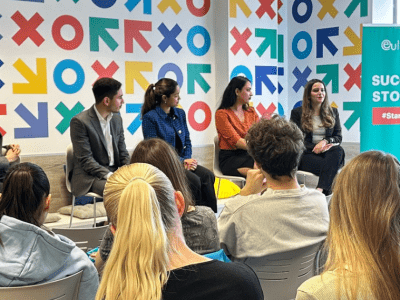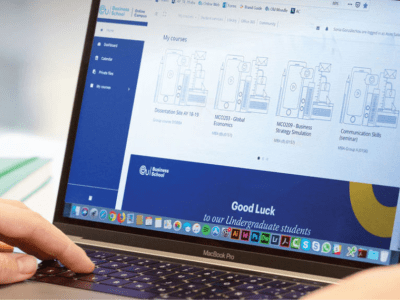In an increasingly globalized business world, interaction with other cultures is both expected and unavoidable. Although this kind of intercultural work often presents unique challenges, it can also be a very rewarding experience when approached thoughtfully. During her presentation to EU Business School students, brand management expert Michaela Pöhlmann shared her experiences and insights regarding best practice while working in culturally-diverse environments.
Michaela talked about her early experiences working with clients and colleagues of diverse cultures, focusing on how different values and expectations could cause frustration and miscommunication. Her message was that working with other cultures can affect professional projects either positively or negatively, so what’s important is to get the best out of a culturally diverse team by implementing a sensitive and flexible approach.
The Cultural Iceberg
Michaela used the iceberg model to demonstrate the visible and hidden aspects that compose our cultural context. The 10% of our culture that is visible can be seen in our food, dress, language, holidays and art. However, below the surface there are deep underlying values that inform cultural understanding. Some examples of these include concepts of time and family, attitudes toward work and death, notions of courtesy and leadership, and approaches to problem-solving and decision-making.
Different cultures have different communication styles and rules which may not be obvious to outsiders, like how they display emotion or what they consider appropriate personal space. All of these elements can influence how business is conducted in a specific culture. It’s important that our ideas about different cultures include these hidden elements and that avoid shallow stereotypes.
6 Categories of a Culture
Through use of the Hofstede model, Michaela showed how you can compare different cultures based on six key categories:
- Egalitarianism vs hierarchy: To what extent are decisions made by the collective, and how much trust is placed in leadership?
- Collectivism vs individualism: How important is it to serve the interests of the collective, or do people prioritize individual goals instead?
- High uncertainty avoidance vs risk-taking behavior: How willing are certain cultures to try new things, and how attached are they to tradition?
- Femininity vs masculinity: Is nurturing prioritized over the pursuit of power, or vice versa?
- Short-term orientation vs long-term orientation: How far into the future does the collective imagination plan for?
- Restraint vs indulgence: To what extent do people pursue pleasure, and how important is self-discipline as a value?
Practical Applications of Cultural Theory
Using this model, Michaela shared her own experiences of working with people from China and India as well as her native Germany. For example, she noticed that in China decision-making is highly centralized. In Germany, employees felt comfortable disagreeing openly with leadership, but this was not the case in China. Indian colleagues expected clear directions from superiors whereas German colleagues had a more questioning approach. Understanding these differences was vital so that she communicated with the correct person in an appropriate and respectful way.
She also observed that in China there is a greater emphasis on the collective. This meant that the shared goals of the group are prioritized over the individual; however, those outside the group could feel excluded by this unity. In her experience India has a stronger focus on personal responsibility than China, but the importance placed on belonging to a social framework means that external perspectives, such as that of family and professional peers, are valued far more highly in India than in Germany. This meant that the direct communication style favored in Germany could be seen as offensive and hurtful in this context, so it was important to incorporate this understanding into her approach.
Lastly, Michaela shared her reflections regarding uncertainty avoidance in different cultures. She shared her perspective of Germany as being a highly-analytical culture that prefers to plan comprehensively before taking action, and she compared this with India, which has a generally higher tolerance for the unexpected and so a greater acceptance of imperfection at the planning stage. These variations in values naturally have a big impact on decision-making processes and have to be taken into consideration when working cross-culturally in order to ensure effective cooperation.
Rules to Remember
Given that the students of EU Business School come from very culturally diverse backgrounds, it’s unsurprising that there were many perspectives to be shared regarding experience of international differences. Michaela agreed with one student’s contribution that cultural diversity is very subjective and fluid: everyone absorbs culture in their own way and to varying degrees. The goal, then, is to be thoughtful and adaptable about differences without over-simplifying or generalizing complex cultures.
With this in mind, Michaela shared some key principles for good practice when it comes to approaching cultural diversity in the workplace:
- Understand and analyze your own culture first. Remember that your country is not the benchmark by which to measure others. By analyzing your own culture, you can discover its unique characteristics that may seem unusual to others.
- There is no one right culture. The goal is to develop an acceptance of difference and a shared desire to work and live together as positively as possible without trying to “fix” or change other people.
- It’s worth taking intercultural training. Michaela recommended that students look for opportunities to learn more about this subject. The world is only going to become more interconnected so cultural understanding will increase in importance.
- Seek to understand the communication styles of different cultures. Some are more direct, some are more polite and some are more sensitive. Spending extra time and effort to be courteous is always a good idea.
- Turn on cameras during video calls. As meetings continue to move online, it can be difficult to build a rapport with the people you work alongside. This is especially true if there are cultural barriers to overcome. Access to body language and facial expressions can help you make deeper connections.
- Build relationships with colleagues and don’t underestimate the importance of small talk. It’s worthwhile to share some personal information and try to get to know your colleagues on an individual level. Any goodwill previously established between you will help ease future moments of discomfort as a result of cultural differences.
- Avoid becoming frustrated. Although it can be difficult, try to be patient and look at practical ways to improve your intercultural co-working situation rather than being excessively critical of colleagues from different cultures.










